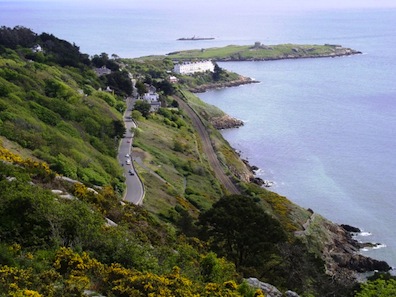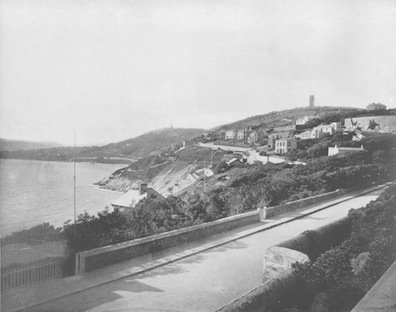At the beginning of Nestor Stephen reflects that
Armstrong's family lives on "Vico Road, Dalkey," which runs
along the seacoast southwest from the prosperous suburb of
Dalkey, approximately 10 miles southeast of central Dublin.
According to Ellmann Joyce modeled Armstrong on a boy named
Clifford Ferguson who did in fact live in Vico Terrace (153),
and clearly the chief purpose of the detail is to indicate
that the Armstrongs are "Welloff people." The land along the
Dalkey Coast was prime real estate, as the caption to the
Finerty photo here suggests. But it is hard to dismiss
entirely the possibility that Joyce may have been alluding to
the philosophy of Giambattista Vico, which plays an important
role in Finnegans Wake.
Joyce was certainly
reading the 18th century historiographer by the time he composed
Nestor, and he would not have used the name Vico
without awareness that he was sounding literary echoes. Stuart
Gilbert, to whom he imparted so many confidences, thought it
meaningful that it should show up in a chapter about history:
"The very atmosphere of Mr Deasy's study is 'historical'—it
bears for Stephen an impress of the 'dingdong round' of
cyclical return recognized
by Vico. (It is significant that the name of Vico occurs in this
episode...)" (
James Joyce's Ulysses, 95). Another close
acquaintance, Padraic Colum, recalled Joyce telling him about
"Vico’s theory of the cycles in history. These historical cycles
connected in some way with the Vico Road that follows the bend
of Dublin Bay between Dalkey and Killiney—in Joyce’s mind they
did anyway." (
Our Friend James Joyce, 122).
The question for readers of Ulysses, though, is
whether Joyce built Viconian ideas into the book. There are no
other details in Nestor that might reasonably be
regarded as allusions, but Ellmann does note a possible echo
in Scylla and Charybdis. He quotes a passage from
Benedetto Croce's description of Vico's ideas in his Aesthetic
(1902): "Man creates the human world, creates it by
transforming himself into the facts of society: by thinking it
he re-creates his own creations, traverses over again the
paths he has already traversed, reconstructs the whole
ideally, and thus knows it with full and true knowledge"
(Ellmann, 340n). As Ellmann recognizes, this sentence shows a
striking resemblance to the theory of peripatetic solipsism
that Stephen advances in the library.


